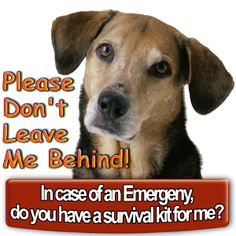This guide is primarily about dogs and cats. For tips on disaster planning for livestock, horses, birds, reptiles, or small animals such as gerbils and hamster go to Ready.gov.
Top Tips for Keeping Your Pets Safe During a Disaste
.If it’s not safe for you to stay in your home during an emergency, it’s not safe for them either!
- .Include supplies for your pet in your emergency kit, or assemble an emergency kit for your pet.
- .Make an evacuation plan for you and your pets. Many hotels and shelters do not accept animal guests, other than service animals.
Assemble an Emergency Kit for Your Pet
Keep items in an accessible place and store them in sturdy containers so that they can be carried easily.
Your kit should include:
- Sturdy leashes, harnesses and/or carriers to transport pets safely and ensure that they can’t escape.
- Food, drinking water, bowls, cat litter/pan and a manual can opener if you pet eats canned food.
- Medications and copies of medical records stored in a waterproof container.
- A first aid kit.
- Current photos of you with your pet(s) in case they get lost. Since many pets look alike, this will help to eliminate mistaken identity and confusion.
- Information on feeding schedules, medical conditions, behavior problems, and the name and number of your veterinarian in case you have to foster or board your pets.
- Pet beds and toys, if easily transportable.
-
Create an Emergency Plan for Your Pet
The best way to protect your household from the effects of a disaster is to have a disaster plan. If you are a pet owner, that plan must include your pets. Being prepared can save their lives.
Know a Safe Place to Take Your Pets
If you have to evacuate your home during a disaster, the best way to protect your pets is to evacuate them too. If it’s not safe for you to stay behind then it’s not safe to leave pets behind either.
- Know which hotels and motels along your evacuation route will accept pets in an emergency. Call ahead for reservations if you know you may need to evacuate. Ask if no pet policies could be waived in an emergency.
-
- Most American Red Cross shelters cannot accept pets because of health and safety concerns and other considerations. Service animals that assist people with disabilities are allowed in Red Cross shelters.
-
- Know which friends, relatives, boarding facilities, animal shelters or veterinarians can care for your animals in an emergency. Prepare a list with phone numbers.
-
- Although your animals may be more comfortable together, be prepared to house them separately.
-
- Include your pets in evacuation drills so that they become used to entering and traveling in their carriers calmly.
-
- Make sure that your pet’s vaccinations are current and that all dogs and cats are wearing collars with securely fastened, up-to-date identification. Many pet shelters require proof of current vaccinations to reduce the spread of disease.
-
- Consider having your pet “microchipped” by your veterinarian.
-


Leave a Reply